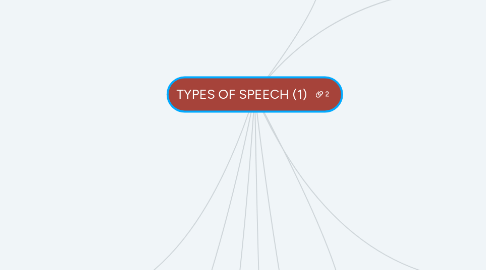
1. I
2. informative
2.1. principle of information speech
2.1.1. Focus on Your audience
2.1.2. Stress relevance and Usefulness
2.1.3. Limit the amount of Information
2.1.4. adjust the Level of Complexity
2.1.5. relate New Information to Old
2.1.6. Vary the Levels of abstraction
2.1.7. Make Your Speech easy to remember
2.2. the main types of informative speeches
2.2.1. Speeches of description
2.2.1.1. Describing an Object or Place
2.2.1.2. Describing a Person, Real or Generalized
2.2.1.3. Describing an Event or Process
2.2.2. Speeches of definition
2.2.2.1. Defining a Term
2.2.2.2. Defining a System or Theory
2.2.2.3. Defining Similar and Dissimilar Terms or Systems
2.2.3. Speeches of demonstration
2.2.3.1. Demonstrating How to Do Something
2.2.3.2. Demonstrating How Something Operates
3. Differences between Informative and Persuasive Speeches
4. informative
4.1. Supportİ Primarily examples, definitions, numerical data, and presentation aids
5. Purpose: To communicate new information to listeners
6. persuasive
6.1. Goals of Persuasive Speaking
6.1.1. To Strengthen or weaken Attitudes, Beliefs, or Values
6.1.2. To Change Attitudes, Beliefs, or Values
6.1.3. To motivate to Action
6.2. Principles of Persuasive Speaking
6.2.1. Focus on Your Audience
6.2.2. Identify with Your Audience
6.2.3. Secure a Yes Response
6.2.4. Anticipate Selective Exposure
6.2.5. Use Positive labeling
6.2.6. Ask for Reasonable Amounts of Change
6.2.7. Provide Social Proof
6.2.7.1. positive social proof
6.2.7.2. negative social proof
6.2.8. Motivate Your listeners with limited Choices
7. The Three Persuasive Proofs
7.1. Logical Proof
7.1.1. Reasoning from Specific Instances and Generalizations
7.1.2. Reasoning from Causes and Effects
7.1.3. Reasoning from Sign
7.1.4. Listening to logical Arguments and the Fallacies of Reasoning
7.2. Emotional Proof
7.2.1. Physiological needs
7.2.2. Safety needs
7.2.3. Belonging and love needs
7.2.4. Self-Esteem needs
7.2.5. Self-Actualization needs
7.3. Credibility Proof
7.3.1. Competence
7.3.2. Character
7.3.3. Charisma
